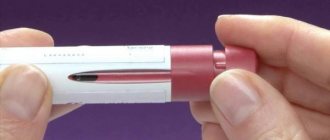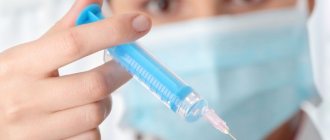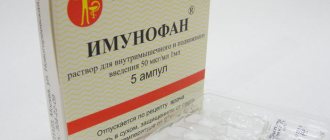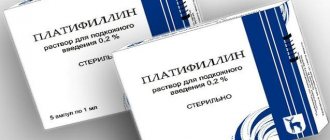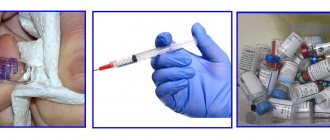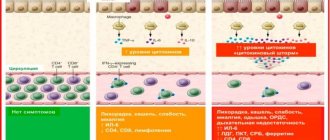The antidiabetic drug Humulin NPH contains isophane insulin, which has an average duration of action. It is intended for continuous use to maintain blood glucose levels within normal limits. Produced as a suspension for subcutaneous administration in vials in the USA by Eli Lilly and Company. And the French company produces insulin Humulin NPH in the form of cartridges with a syringe pen. The drug has the form of a cloudy or milky suspension.
Pharmacodynamics and pharmacokinetics
Humulin NPH is a DNA recombinant human insulin with an intermediate duration of action, the main effect of which is to regulate glucose metabolism . The drug also exhibits anabolic effectiveness.
In the tissues of the human body (except for brain tissue), insulin Humulin NPH activates the transport of amino acids and glucose , and also accelerates the processes of protein anabolism . In parallel, in the liver, the drug promotes the formation of glycogen from glucose , stimulates the transformation of excess glucose into fat , and inhibits gluconeogenesis .
The onset of action of Humulin NPH insulin is observed 60 minutes after administration, with maximum effectiveness achieved in the period from 2 to 8 hours and a duration of action within 18-20 hours.
Observed individual differences in insulin depend on the choice of dose, injection site, and physical activity of the patient.
Important Notes
So, the indications for the use of Humulin NPH are clear. The specifics of the drug as a whole are also clear. But there are still some nuances that are important to know.
For example, a syringe pen will not allow a person to set a dose that would exceed the number of units remaining in it. There is no need to administer another one if there is any doubt as to whether the full dose has been applied.
The pen syringe must not be used if it has been out of the refrigerator longer than stated in the instructions. And it is also forbidden to store it with an attached needle. In this case, the insulin inside either dries out or leaks out, which is fraught with dangerous consequences (such as the formation of bubbles inside or clogging of the needle).
Pen syringes should be stored in the refrigerator at a temperature of 2 to 8 °C. If they freeze, they will not be usable.
As for disposal, Humulin NPH syringes should be placed in lockable, puncture-proof containers. For example, those intended for waste or biohazardous substances. And then dispose of it.
The shelf life of Humulin NPH is 3 years. But from the start of use - 28 days.
Side effects
The main side effect is hypoglycemia , which in severe cases can cause loss of consciousness and even death (rarely).
There is also a minimal likelihood of developing lipodystrophy .
Allergic manifestations of a systemic nature:
- generalized itching;
- dyspnea;
- labored breathing;
- decreased blood pressure;
- increased sweating ;
- increased heart rate.
Local allergic manifestations:
- swelling or itching in the injection area (usually disappears within a few weeks);
- hyperemia.
Pharmacological authorities
Pharmacodynamics.
Humulin NPH is a medium-grade insulin preparation.
The main function of insulin is to regulate glucose metabolism. In addition, insulin stimulates anabolic and anti-catabolic processes in various tissues. In meat tissues, prior to such effects, there is an increased synthesis of glycogen, fatty acids, glycerol and protein, as well as an increased deposition of amino acids with the simultaneous suppression of the processes of glycogenolysis, gluconeogenesis, ketogenesis, l Use, protein catabolism and amino acid depletion.
Below in the figure, a typical profile of insulin activity (glucose utilization curve) is indicated by a thick line after intensive injection. Possible variability in insulin activity and/or intensity among different patients is depicted in the shaded area of the graph. Individual variability lies in factors such as dose volume, temperature at the site of injection, and level of physical activity of the patient.
| Insulin activity |
Hour (hour)
Pharmacokinetics.
The drug Humulin NPH is a human insulin that is prepared using advanced recombinant DNA technology.
Pharmacokinetics of insulin does not reflect the metabolic activity of the hormone. Therefore, when considering nutritional data on insulin activity, it will be more important to examine the glucose utilization curves (as determined by the diet).
At the time of toxicological investigations, no serious adverse events associated with the drug were identified.
Instructions for use Humulin NPH
The dosage of Humulin NPH is selected individually, depending on glycemic .
IV injections of Humulin NPH are prohibited!
The emulsion should be administered subcutaneously; in some cases, intramuscular injections are allowed. Subcutaneous injection is carried out in the abdomen, shoulder, buttock or thigh. The injection sites should be alternated so that no more than one injection is given at one site over a 30-day period.
Subcutaneous injections require certain administration skills and precautions. It is necessary to avoid getting the needle into the blood vessels, not to massage the injection site, and also to handle the devices for administering the drug correctly.
Preparation and administration of Humulin NPH
In order to resuspend insulin , before use, it is recommended to roll the vials and cartridges of the drug Humulin NPH 10 times in the palms and shake the same number of times (rotating 180°) until the drug acquires a state close to milk or a homogeneous liquid of a turbid shade. The drug should not be shaken vigorously, as the foam formed in this way may interfere with the exact dose.
Vials and cartridges must be checked with special care. Avoid using insulin with flakes of sediment or white particles adhering to the sides or bottom of the vial, giving the appearance of a frosty pattern.
The design of the cartridge does not allow its contents to be mixed with other insulins , as well as the cartridge itself not to be refilled.
When using vials, the emulsion is drawn into an insulin syringe that corresponds in volume to the insulin (for example, 100 IU/1 ml of insulin = 1 ml syringe) and administered in accordance with the doctor’s recommendations.
When using cartridges, you must follow the instructions of the pen manufacturer for installing them, attaching the needle, and administering insulin, for example, instructions for Humulin NPH in the KwikPen syringe pen.
Immediately after the injection, you should use the outer needle cap to remove the needle itself and destroy it in a safe manner, then close the pen with the cap. This procedure ensures further sterility, prevents the entry of air, and prevents leakage of the drug and its possible clogging.
Needles and syringe pens cannot be reused or used by others. Vials and cartridges are used once until the drug is completed, and then discarded.
It is possible to administer Humulin NPH in combination with Humulin Regular . For this purpose, in order to prevent longer-acting insulin insulin . This mixture is recommended to be administered immediately after mixing. To accurately dose the two insulins, different syringes may be used.
Rules for using the drug
They are described in detail in the instructions for use of Humulin NPH. But before describing each method of use, it is necessary to stipulate that it is different for each patient. And, as mentioned above, the product is available in several forms.
If a person must take Humulin NPH in a vial, it must be rolled out thoroughly before use so that the insulin is completely resuspended. It is important that the product becomes a homogeneous cloudy liquid. Do not shake, otherwise foam will appear. It is an obstacle to the correct dose set.
Also, do not use the product if after mixing there are flakes or adhered white solid particles remaining.
As for the instrument, Humulin NPH insulin must be administered using a special syringe that corresponds to the concentration of the solution used.
Now about using cartridges. They also need to be rolled out between your palms, but a certain number of times – 10. Then turn them over 180°. You also need to do this 10 times. Otherwise, the insulin will not be completely resuspended. But inside each such device there is a small glass ball - it makes mixing the composition easier. It is important to understand that cartridges are not intended for refilling.
Overdose
As such, there is no specific overdose of Humulin NPH. Symptoms are considered to be manifestations of hypoglycemia , accompanied by increased sweating , lethargy, tachycardia , headache, pale skin, trembling , confusion , and vomiting.
In some cases, the symptoms that precede hypoglycemia ( long-term diabetes or its intensive control) may change.
Manifestations hypoglycemia are usually relieved by oral intake of sugar or glucose ( dextrose ). In the future, you may need to adjust your diet, insulin , or physical activity.
Correction of hypoglycemia is carried out by subcutaneous or intramuscular injection of glucagon , followed by oral intake of carbohydrates .
Manifestations of severe hypoglycemia may be accompanied by coma , neurological disorders or seizures , which are localized by intravenous injection of concentrated glucose ( dextrose ) or subcutaneous or intramuscular administration of glucagon . In the future, in order to prevent recurrence of symptoms, it is necessary to eat foods rich in carbohydrates .
Treatment during pregnancy
A pregnant woman must keep her glycemia under control if she has diabetes. As a rule, in the first trimester the need for insulin decreases, but by the second and third it increases.
Every woman must notify her doctor about planning or pregnancy in order to adjust therapy. Also, dosage changes are required during lactation. Most often, a special diet is prescribed.
The drug is safe for pregnant and lactating women as it does not have a mutagenic effect.
Interaction
The hypoglycemic effectiveness of Humulin NPH decreases with concomitant use oral contraceptives , thyroid hormones, glucocorticoids , thiazide diuretics , tricyclic antidepressants , Diazoxide .
The combined use of ethanol , hypoglycemic drugs (oral), salicylates , MAO inhibitors, sulfonamides , beta-blockers enhance the hypoglycemic effects of Humulin NPH.
Reserpine , clonidine and beta-blockers can alleviate the symptoms of hypoglycemia.
Compound
Humulin is a suspension of human insulin and protamine sulfate. NPH – neutral protamines of Hadegorn, indicating the neutrality of the drug. Thanks to this additive, the effect of the drug is achieved gradually and lasts longer compared to short-term remedies. 1 - 2 injections are required per day - this helps to normalize glycemia. Usually the medicine is prescribed for mixed treatment with short-acting insulin; for type 2 diabetes mellitus it can be used as monotherapy. International nonproprietary name (INN) is insulin isophane. Latin name: Humulin NPH.
1 ml of the drug contains 100 IU/ml of active substance. Additional components included:
- metacresol;
- glycerol;
- protamine sulfate;
- phenol;
- sodium hydrogen phosphate;
- zinc oxide;
- hydrochloric acid solution 10% concentration;
- water for injections.
special instructions
decide whether to switch the patient to another drug or type of insulin . This change must take place under strict control of the patient's condition.
A change in the type of insulin activity (Regular , M3 , etc.), its type ( human , porcine , analogue ) or production method ( animal origin or DNA recombinant ) may require dose adjustments, both at the first administration and during therapy , gradually over weeks or months.
Insulin dependence may decrease with insufficiency of kidney , pituitary, adrenal , thyroid, and liver .
With emotional stress and certain pathologies, there may be an increased need for insulin .
Sometimes dosage adjustments are appropriate when changing your diet or increasing your physical activity .
In some patients, when using human insulin , the symptoms preceding hypoglycemia may differ from those when using animal insulin or be less severe.
Normalization of plasma glucose levels , due to intensive insulin therapy , leads to the disappearance of all or some manifestations of hypoglycemia , about which the patient must be informed.
Symptoms of advancing hypoglycemia may be smoothed out or changed in the case of concurrent use of beta-blockers , diabetic neuropathy or prolonged diabetes mellitus .
In some cases, local allergic manifestations may develop for reasons unrelated to the effects of the drug (for example, skin irritations due to the use of a cleansing agent or improper injection).
Rarely, systemic allergic reactions may require immediate therapy ( desensitization or insulin replacement ).
Due to the potential for symptoms of hypoglycemia , every precaution should be taken when performing hazardous work or driving a vehicle.
Indications
The instructions for use of Humulin NPH indicate a narrow list of conditions for which doctors usually prescribe this drug to patients. What are these conditions? Among them:
- Pregnancy with non-insulin-dependent diabetes mellitus. But only if he belongs to type 2.
- Newly diagnosed diabetes mellitus.
- This is an endocrine disease, accompanied by indications for insulin therapy.
This is all the testimony. Thus, Humulin NPH is necessary for people who need insulin to maintain normal blood sugar levels.
Humulin NPH price, where to buy
You can buy Humulin NPH on average: 10 ml bottle No. 1 – 550 rubles; cartridges 3 ml No. 5 – 1500 rubles.
- Online pharmacies in RussiaRussia
- Online pharmacies in UkraineUkraine
Pharmacy Dialogue
- Humulin NPH cartridge 100IU/ml 3ml No. 5Lilly Franc/Ortat
RUB 1,002 order
show more
Release form
Humulin has 2 release forms:
- glass bottles with the drug with a volume of 10 ml;
- cartridges for reusable syringe pens with a volume of 3 ml, 5 pieces per pack.
Insulin is administered subcutaneously, rarely intramuscularly. Intravenous administration is possible for another type - insulin "Humulin" Regular, for others it is prohibited. This ultra-short medication is injected into a vein in severe cases of hypoglycemia and only as directed by a doctor. “Humulin M3” - the instructions indicate a short-acting solution.
The drug "Humulin Lente" is administered subcutaneously by injection with a regular syringe. The suspension costs less, but cartridges are much more convenient to use.
Syringe
Analogs
When it is not possible to purchase Humulin or, due to individual characteristics, it does not have the desired effect, you can buy high-quality analogues of this drug. Among the main and popular drugs with a similar composition, it is worth highlighting:
- Actrapid. Created on the basis of human insulin, it is a short-acting drug.
- Insular Active. Obtained on the basis of human DNA recombination, it is also a short-acting drug.
- Novorapid Penfil. Using biotechnology, the main component of the drug, insulin, was obtained. Has a short-term effect.
- Novorapid Flexpen. Contains insulin aspart and anhydrous insulin. Valid for 6-8 hours.
- Humalog. Contains insulin lispro, quite similar to human insulin. Has a validity period of 2-5 hours.
- Epidra. Contains insulin glulisine.
Like Humulin, any analogue should be purchased only after consultation with your doctor, since otherwise, you can cause hypo or hyperglycemia, which leads to coma or death.
Interactions with other medicinal drugs and other types of interactions
Some medications affect glucose metabolism, so consult your doctor before taking any other medications at the same time as you need to take human insulin. The doctor is responsible for taking every possible mutual approach if the patient is taking any other medical treatment.
Insulin requirements may increase when drugs with hyperglycemic activity are ingested, such as glucocorticoids, thyroid hormones and growth hormone, danazol, β2-sympathomimetics (eg ritodrine, salbutamol, terbutal). n), thiazide.
Insulin requirements may change due to the use of drugs with hypoglycemic activity, such as oral hypoglycemic drugs, salicylates (such as acetylsalicylic acid), and antidepressants. (monoamine oxidase inhibitors), angiotensin converting enzyme inhibitors (captopril, enalapril), angiotensin II receptor blockers , non-selective beta blockers or alcohol.
Somatostatin analogues (octreotide, lanreotide) can both increase and change insulin requirements.
Features of good stagnation
Any replacement type or brand of insulin may be determined under close medical supervision. Change of concentration, brand (generator), type (generic, NPH, blended), type (cooked insulin, human insulin, analogue of human insulin) and/or type of generation (DNA-recombinant insulin or insulin n animal gait) may require a change in dosage.
Dosing for different treatments with human insulin may vary from dosing for stagnant insulin. The need for adjusted doses may increase with the first dose or over the course of several weeks or months.
In some patients who developed hypoglycemic reactions after switching from formula insulin to human insulin, early post-chewing symptoms of hypoglycemia were less pronounced and more noticeable than the symptoms that were previously observed in these patients when treated with artificial insulin. Patients with significant increases in blood glucose levels (for example, due to intensification of insulin therapy) may not be able to avoid these effects in the future or may experience early pre-chewing symptoms. Hypoglycemia, please tell them about it. In cases where early pre-chewing symptoms of hypoglycemia may be non-specific and less pronounced, it can be caused by severe diabetes, deterioration of the nervous system in diabetic patients or taking medications iv, such as beta-blockers.
Hypoglycemic or hyperglycemic reactions, if not controlled, can lead to loss of information, which can be fatal.
Inappropriate doses or rapid treatment, especially in insulin-dependent diabetes, can lead to hyperglycemia and ketoacidosis, which are potentially fatal.
When bathed in human insulin, antibodies can be produced, albeit in lower concentrations, as long as the purified insulin is frozen.
The need for insulin changes significantly with illnesses of the suprathyroid glands, pituitary gland, thyroid gland and with the presence of thyroid gland or liver failure.
The need for insulin may also increase during periods of illness or emotional stress.
The need for adjusted doses may occur due to a change in the intensity of physical exercise or in accordance with the food regime.
Combined with pioglitazone
Episodes of heart failure have been reported when taking pioglitazone with insulin in combination, especially in patients with low risk factors for developing heart failure. This information must be followed when considering the combination of Humulin NPH and pioglitazone. Due to the use of this combination, it is necessary to monitor the patient's condition for the development of symptoms of heart failure, increased body weight, and the appearance of bumps. Pioglitazone treatment should be taken if cardiac symptoms are relieved.
Additional speeches.
It is advisable to administer less than 1 mmol sodium (23 mg) per dose to effectively “do not treat sodium.”
Suspension during pregnancy or breastfeeding.
Patients with insulin-dependent cervical diabetes or gestational diabetes who are discontinuing insulin therapy require close monitoring throughout the entire period of pregnancy. The need for insulin changes during the first trimester of pregnancy, after which it increases during the second and third trimesters. Patients with blood diabetes should inform the doctor about the need or planning of pregnancy.
During pregnancy, patients with diabetic diabetes require careful monitoring of blood glucose levels, as well as overall health.
Patients with diabetes during breastfeeding may need adjusted insulin doses and/or diet regimens.
This is due to the fluidity of the reaction during treatment with vehicles or other mechanisms.
The ability of patients to stagnate insulin, concentrate and react may be impaired as a result of hypoglycemia. This may become a risk factor if the workload may be of particular importance (including the need for transportation by vehicles or robots with other mechanisms).
Patients are then informed about the most immediate steps to avoid hypoglycemia that must be experienced during the car bath. This is especially important for those patients who experience less or less daily symptoms of hypoglycemia or who have frequent episodes of hypoglycemia. For such conditions, it is necessary to evaluate the completeness of the vehicle's maintenance.
Side effects
Hypoglycemia is the most common side effect of insulin therapy in patients with diabetes. Severe hypoglycemia can lead to loss of speed, and in extreme cases – to death. The specific frequency of hypoglycemic episodes cannot be determined, but is a result of both insulin dosage and other factors, such as the patient's lifestyle and physical activity.
Local allergic reactions are often possible (frequency ranges from 1/100 to <1/10), including changes at the site of injection: reddened skin, swelling, itching. The stench begins to pass over a period of many days to many years. Sometimes, such a situation is not due to insulin, but to other factors, for example, the presence of toxic substances in the stock of methods for cleansing the skin or the unsatisfactory technique of injection.
A systemic allergic reaction occurs only rarely (<1/10000), but is a potentially serious side effect and is a generalized form of allergy to insulin. This may manifest itself as a tingling sensation over the entire surface of the body, in the buttocks, hoarse breathing, decreased arterial pressure, rapid pulse and increased sweating. Severe episodes of generalized allergies are not safe for life. In cases of severe allergy to Humulin NPH, patients with a severe form of allergy to Humulin NPH should be kept safe from regular visits. There may be a need for insulin replacement or desensitization therapy.
Lipodystrophy at the injection site occurs infrequently (frequency ranges from 1/1000 to <1/100).
It was reported that episodes of swelling appeared during the period of stagnation of insulin therapy, but only occasionally when early poor metabolic control was observed during intensive insulin therapy.
What you need to pay attention to
You cannot stop the course of medication on your own or increase or decrease the dose without permission. This can cause a person to develop ketoacidosis or hyperglycemia, which can be life-threatening.
For safer use of the drug, it is better to regularly check your glucose levels, since in rare cases hypoglycemia may be mild. Failure to correct hyper or hypoglycemia in a timely manner can sometimes lead to death.
The doctor may prescribe the administration of other medications of medium duration, but it is prohibited to change them yourself.
Diabetes pills
When a person has problems with the kidneys or liver, or the vital processes of the adrenal or thyroid glands are disrupted, it is undesirable to administer insulin.
Overdose
There is no specific reason for insulin overdose, since the level of glucose in the blood is the result of a complex interaction between insulin, glucose, and other metabolic processes. The cause of hypoglycemia may be excess insulin in relation to the amount of food taken and energy consumed.
Manifestations of hypoglycemia include bloating, confusion, rapid heart rate, headache, sweating, vomiting.
Mild stage hypoglycemia can be treated with oral glucose or products that can be used as a remedy. Correction of moderately severe hypoglycemia can be carried out with the help of internal or subcutaneous administration of glucagon with subsequent intake of carbohydrates after stabilization of the patient's condition. Patients who are unresponsive to glucagon administration should receive intravenous glucose supplementation. If the patient is in a comatose state, then glucagon is administered internally or subcutaneously. If glucagon is absent or there is no reaction to its administration, it is necessary to administer glucose doses internally. The patient must be encouraged immediately after they arrive.
There may be a need for increased intake of carbohydrates and medical observation, debris after obvious clinical deterioration may lead to a relapse of hypoglycemia.

